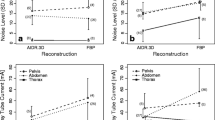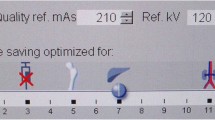Abstract
Purpose
To investigate how elevation of the arms affects diaphragm height.
Materials and methods
We retrospectively reviewed angiography and computed tomography (CT) portography data from 44 patients who were treated for hepatocellular carcinoma at our institution from July 2013 to May 2014. Diaphragm height was determined independently by two radiologists as the distance from the upper edge of the first lumbar vertebra to the highest point of the right diaphragm. The differences in height between angiography and CT images were compared using a paired t-test. We also evaluated the influence of table height and distance between X-ray tube and flat panel detector [source–image distance (SID)] on a phantom model.
Results
Diaphragm height was higher on CT images [mean ± standard deviation (SD), 113.2 ± 27.2 mm] than on angiography images (105.5 ± 27.8 mm; P < 0.001). Inter-rater correlation was excellent both in angiography (R = 0.920; P < 0.001) and CT (R = 0.950; P < 0.001) measurements. Table height and SID had no influence on diaphragm height measurements (P = 0.33).
Conclusion
The diaphragm elevation was observed on CT with arm elevation compared with angiography without arm elevation.



Similar content being viewed by others
References
Tajima T, Nishie A, Asayama Y, Ishigami K, Ushijima Y, Kakihara D, et al. Safety margins of hepatocellular carcinoma demonstrated by 3-dimensional fused images of computed tomographic hepatic arteriography/unenhanced computed tomography: prognostic significance in patients who underwent transcatheter arterial chemoembolization. J Comput Assist Tomogr. 2010;34:712–9.
Abi-Jaoudeh N, Kruecker J, Kadoury S, Kobeiter H, Venkatesan AM, Levy E, et al. Multimodality image fusion-guided procedures: technique, accuracy, and applications. Cardiovasc Interv Radiol. 2012;35:986–98.
Appelbaum L, Mahgerefteh SY, Sosna J, Goldberg SN. Image-guided fusion and navigation: applications in tumor ablation. Tech Vasc Interv Radiol. 2013;16:287–95.
Wood BJ, Kruecker J, Abi-Jaoudeh N, Locklin JK, Levy E, Xu S, et al. Navigation systems for ablation. J Vasc Interv Radiol. 2010;21:S257–63.
Redmond KJ, Song DY, Fox JL, Zhou J, Rosenzweig CN, Ford E. Respiratory motion changes of lung tumors over the course of radiation therapy based on respiration-correlated four-dimensional computed tomography scans. Int J Radiat Oncol Biol Phys. 2009;75:1605–12.
Nakamoto Y, Sakamoto S, Okada T, Senda M, Higashi T, Saga T, et al. Clinical value of manual fusion of PET and CT images in patients with suspected recurrent colorectal cancer. AJR Am J Roentgenol. 2007;188:257–67.
Weiss D, Ruiz CE, Pirelli L, Jelnin V, Fontana GP, Kliger C. Available transcatheter aortic valve replacement technology. Curr Atheroscler Rep. 2015;17:488–94.
Rengier F, Geisbüsch P, Schoenhagen P, Müller-Eschner M, Vosshenrich R, Karmonik C, et al. State-of-the-art aortic imaging: part II—applications in transcatheter aortic valve replacement and endovascular aortic aneurysm repair. Vasa. 2014;43:6–26.
Kauffmann C, Douane F, Therasse E, Lessard S, Elkouri S, Gilbert P, et al. Source of errors and accuracy of a two-dimensional/three-dimensional fusion road map for endovascular aneurysm repair of abdominal aortic aneurysm. J Vasc Interv Radiol. 2015;26:544–51.
Kaladji A, Dumenil A, Mahé G, Castro M, Cardon A, Lucas A, et al. Safety and accuracy of endovascular aneurysm repair without pre-operative and intra-operative contrast agent. Eur J Vasc Endovasc Surg. 2015;49:255–61.
Ohki T, Tateishi R, Akahane M, Mikami S, Sato M, Uchino K, et al. CT with hepatic arterioportography as a pretreatment examination for hepatocellular carcinoma patients: a randomized controlled trial. Am J Gastroenterol. 2013;108:1305–13.
Couser JI Jr, Martinez FJ, Celli BR. Respiratory response and ventilatory muscle recruitment during arm elevation in normal subjects. Chest. 1992;101:336–40.
Beyer T, Townsend DW, Brun T, Kinahan PE, Charron M, Roddy R, et al. A combined PET/CT scanner for clinical oncology. J Nucl Med. 2000;41:1369–79.
Matsuura T, Takase K, Ota H, Yamada T, Sato A, Satoh F, et al. Radiologic anatomy of the right adrenal vein: preliminary experience with MDCT. AJR Am J Roentgenol. 2008;191:402–8.
Daunt N. Adrenal vein sampling: how to make it quick, easy, and successful. Radiographics. 2005;25:S143–58.
Miyayama S, Yamashiro M, Ikuno M, Okumura K, Yoshida M. Ultraselective transcatheter arterial chemoembolization for small hepatocellular carcinoma guided by automated tumor-feeders detection software: technical success and short-term tumor response. Abdom Imaging. 2014;39(3):645–56. doi:10.1007/s00261-014-0094-0.
Carrafiello G, Ierardi AM, Duka E, Radaelli A, Floridi C, Bacuzzi A, et al. Usefulness of cone-beam computed tomography and automatic vessel detection software in emergency transarterial embolization. Cardiovasc Intervent Radiol. 2016;39(4):530–7. doi:10.1007/s00270-015-1213-1 (Epub 2015 Oct 20).
Acknowledgments
This study was supported by a Grant-in-Aid for Scientific Research from the Ministry of Education, Culture, Sports, Science and Technology, Japan.
Author information
Authors and Affiliations
Corresponding author
Ethics declarations
Written informed consent was obtained from all patients, and the study was approved by the local ethics committee.
Conflict of interest
There are no conflicts of interest to declare.
About this article
Cite this article
Onozawa, S., Murata, S., Kimura, T. et al. Diaphragm height varies with arm position: comparison between angiography and CT. Jpn J Radiol 34, 724–729 (2016). https://doi.org/10.1007/s11604-016-0579-6
Received:
Accepted:
Published:
Issue Date:
DOI: https://doi.org/10.1007/s11604-016-0579-6




